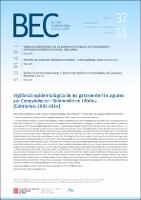Vigilància epidemiològica de les gastroenteritis agudes per Campylobacter i Salmonella no tifòdica (Catalunya, 2005-2014)
Author
Date
2016-11Permanent link
https://hdl.handle.net/11351/2998ISSN
2385-720X
DL
B. 11287-2015
Abstract
Introduction: Campylobacter and non-typhoidal Salmonella are the main cause of food poisoning (FP) and acute gastroenteritis (AGE) around the world. The objective of this study is to describe the epidemiology of the AGE caused by Campylobacter and nontyphoidal Salmonella in Catalonia between 2005 and 2014, as well as the study of antimicrobial resistance during 2012-2014.
Methods: retrospective study of the statements of acute episodes of Campylobacter and non-typhoidal Salmonella reported to the Catalan Microbiological Reporting System during 2005-2008 and 2009-2014. The following variables have studied: sex, age, reporting healthcare center, week and year of reporting, sample, diagnostic technique, species and serotypes, and antimicrobial resistance.
Results: during 2005-2014, 71,911 episodes of AGE have been reported. Campylobacter has accounted for 45.1% (32,421 cases) and non-typhoidal Salmonella (20,630 cases) for 28.7%.
Tax incidences in 2005 have been 34.9 per 100,000 inhabitants for Campylobacter and 34.5 per 100,000 inhabitants for nontyphoidal Salmonella, and in 2014 45 per 100.000 and 24.5 per 100,000 inhabitants, respectively. From 2009 to 2014, reports of Campylobacter from primary health centers have been 19.5% (3,851/19,795), increasing 1.7% compared to 2009. Non-typhoidal Salmonella reports from primary health centers account for 14.5% (1,740/11,974), decreasing a 15.1% regarding 2009. During 2012-2014 antibiotic sensitivity in 3,579 strains of C. jejuni (39.4%), 190 strains of C. coli (55.9%) and 2,379 strains of non-typhoidal Salmonella (37.4%). Resistance levels of Campylobacter jejuni and Campylobacter coli have been high for ciprofloxacin (93.8%
and 94%, respectively) and tetracycline (85.4% and 100%, respectively) and have been low for erythromycin (2.8% and 10.5%, respectively). Non-typhoidal Salmonella has had high resistance
levels for ampicillin (69.5%) and low for ciprofloxacin (1.5%).
Conclusions: from 2005 to 2014 Campylobacter’s incidence has increased although it has remained stable since 2009, while the incidence of non-typhoidal Salmonella has decreased throughout the period. Antibiotic resistance levels of C. jejuni and C. coli have been elevated for ciprofloxacin and tetracycline and low for erythromycin; however, in nontyphoidal Salmonella resistance levels have been elevated for ampicillin and low for ciprofloxacin.
Keywords
Campylobacter; Non-typhoid Salmonella; Food poisoning; Acute gastrointestinal; Zoonosis; Antimicrobial resistanceBibliographic citation
Jambrina-Albiach AM, Ciruela-Navas P, Hernández-Baeza S, Broner S, Jané-Checa M. Vigilància epidemiològica de les gastroenteritis agudes per Campylobacter i Salmonella no tifòdica (Catalunya, 2005-2014). Butll Epidemiol Catalunya. 2016 Nov;37(11):254-264.
Audience
Professionals
This item appears in following collections
- DS - Articles científics [409]
The following license files are associated with this item:

 Private area
Private area Contact Us
Contact Us








